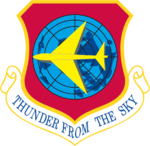404th Fighter Group
| 137th Operations Group | |
|---|---|

|
|
| Active | 1943–1945; 1947-1952; 1952-1975; 1992-present |
| Country |
|
| Allegiance |
|
| Branch |
|
| Role | Air refueling |
| Part of | Oklahoma Air National Guard |
| Garrison/HQ | Will Rogers Air National Guard Base, Oklahoma |
| Motto(s) | Igne Ferroque Hostem Armatum Contere Latin With Fire and Steel Crush the Armored Foe (WW II), Tontrinus e Caelo, then Thunder from the Sky |
| Engagements | European Theater of Operations |
| Decorations |
Distinguished Unit Citation Air Force Outstanding Unit Award French Croix de Guerre with Palm Belgian Fourragere |
| Commanders | |
| Notable commanders |
Maj Gen Stanley F.H. Newman |
| Insignia | |
| 137th Air Refueling Wing emblem |  |
| 137th Fighter-Bomber Wing emblem (Approved 6 June 1952) |  |
| 404th Fighter-Bomber Group emblem |  |
| Tail Marking | Blue tail stripe "Tinker" in yellow |
| Aircraft flown | |
| Fighter | F-51, F-80, F-84, F-86 |
| Transport | C-97, C-124, C-130 |
| Tanker | KC-135 |
The 137th Air Refueling Group is an associate unit of the Oklahoma Air National Guard stationed at Tinker Air Force Base, Oklahoma. If activated for federal service, the group is gained by Air Mobility Command. As of July 2015, the group is in the process of returning to Will Rogers Air National Guard Base and converting from the air refueling to the special operations mission.
The group was first activated during World War II as the 404th Fighter Group flying Republic P-47 Thunderbolts. The group served in the European Theater of Operations from May 1944 until the end of the war. It provided close air support to ground troops following Operation Overlord, the Normandy landings. It earned a Distinguished Unit Citation, French Croix de Guerre with Palm and Belgian Fourragere before inactivating in the fall of 1945.
The group was redesignated the 137th Fighter Group and allotted to the National Guard in 1946, with squadrons in Oklahoma and Kansas. During the Korean War, it was activated and deployed to France as the 137th Fighter-Bomber Group, where it opened Chaumont Air Base.
The unit was replaced in France by a regular unit and returned without personnel or equipment to state control. In 1955, it converted from the fighter bomber to the fighter interceptor mission, and two years later lost its squadrons in Tulsa and in Kansas to new fighter groups.
...
Wikipedia
